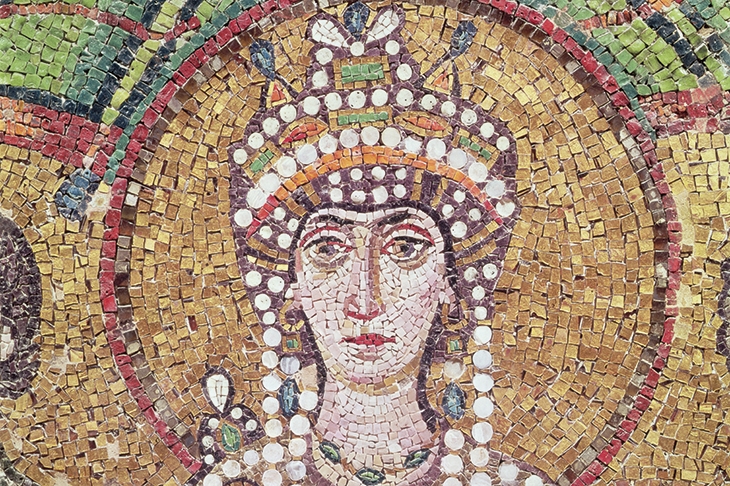When we refer to someone as ‘Byzantine’ we usually mean guileful or too complicated and labyrinthine in manner or speech. Perhaps the term is ill-applied: Byzantium, the medieval Greek city on the Bosporus which the Roman Emperor Constantine I renamed Constantinople, was not in essence an unfathomable, over-hierarchical or manipulative sort of place. It flourished for more than 1,000 years, until the Ottoman Turkish onslaught in the 15th century, by dint of its ‘extraordinary resilience and self-confidence’, says Judith Herrin, a leading Byzantinist.
The northern Italian city of Ravenna, with its wondrous mosaicked churches and gilded mausolea that miraculously survived the aerial bombardments of the second world war, was manifestly also a Byzantine city. Herrin shows how this was so in her scrupulously researched history of the city in its imperial heyday through the period Edward Gibbon chose to call the Dark Ages. While barbarians, vandals and pestilential black boils undermined the achievements of centuries, Ravenna served as the headquarters of Byzantine rule in the west and, through a threefold combination of Roman military prowess, Greek culture and Christian belief, became the place where European Christianity was forged, Herrin argues.
The mosaicked churches and gilded mausolea miraculously survived bombardment in the second world war
Today, by contrast, Ravenna is something of a backwater, situated in Po valley marshland. The British Tuscanites who descend on the hills round Florence over the summer holidays to enact their ‘Toujours Tuscany’ dreams tend to ignore the Adriatic city 100 miles to their east. Oscar Wilde, visiting in 1877, mused on Ravenna’s fallen greatness and the gloomy looking tomb on Via Alighieri where Dante lies buried (Dantis Poetae Sepulchrum). In Ravenna, Wilde found ‘no sound of life or joy’, though inevitably he was aware of past glories. The Roman empire had collapsed in 476 but, wonderfully, a part of it had survived and flourished — the eastern half, with its great capital at Constantinople and the Italic outpost of Ravenna as its gateway into northern Adriatic coastlands and beyond into present-day Sicily. For more than 400 years, according to Herrin, Ravenna was the very ‘crucible of Europe’. Her book, impeccably researched, chronicles the city’s life from 402, when it became the capital of the Roman empire in the west, to 751, when the Germanic longobardi (‘long-beards’, later Lombards) invaded northern Italy.
Herrin’s is not a story of decline, she insists, but one of rebirth. Situated at the strategic midway between the western, Latin-speaking world and the eastern, Greek-speaking world, Ravenna was where past met future, and where classical Rome was transformed into medieval Christendom. The Roman emperor Justinian I and his empress-wife Theodora sought to restore the Roman empire to its old glory and maintain Ravenna as the ‘fulcrum of energies’ that connected Goths, Ostrogoths, Franks and Romans to the Byzantine peoples, and the Roman popes in Rome to the Roman emperors in Constantinople.
In Ravenna’s octagonal church of San Vitale we can marvel today at stupendous mosaic depictions of Justinian and Theodora. Arrayed in jewels amid their entourage, the imperial couple radiate an image of Constantinopolitan power that was intended to awe the Ravennati. Throughout the 6th century the emperor and empress had dominated the Mediterranean world, yet they never visited Ravenna (they preferred to stay put in their glittering eastern imperial polis on the Bosporus). The mosaic-makers surely were familiar with the togas and martial regalia of classical Rome, but they chose to dress Justinian and his wife in Tyrian purple raiments, as the representatives of the new Christian order known as Eastern Orthodoxy.
Herrin, an emerita professor at King’s College London, devoted nine years to researching her history of three and a half centuries of Ravenna’s glory days. She views Byzantine Ravenna, even with its defects, as very much a civilisation, though the contemporary sources are so exiguous that she has had to rely on surviving papyri and other fragmentary registers of the period for her argument. A lucid explicator, she usefully clarifies the bewildering (‘Byzantine’?) wholesale destruction of graven images that occurred in the early-middle period of Byzantium. Much of Christian Constantinople was whitewashed or plastered over on the orders of the iconoclast Byzantine emperor Leo III, who espoused an Old Testament intolerance of images. Ravenna, however, had begun to look religiously to Rome, where the pope was opposed to any such visual purifications, so icons and paintings of holy people were left untouched.
Herrin’s book, though dense with mention of Theodores, Theodosiuses, Theodoras and Theoderics, is eminently worth reading. The colour plates are so sumptuous that the Ravenna mosaics fairly glow on the page. History teaches us that it is on the margins that the greatest change often occurs. Ravenna was on such a margin. Now, perhaps for the first time, the city emerges triumphant from the shadow of the so-called Dark Ages.






Comments